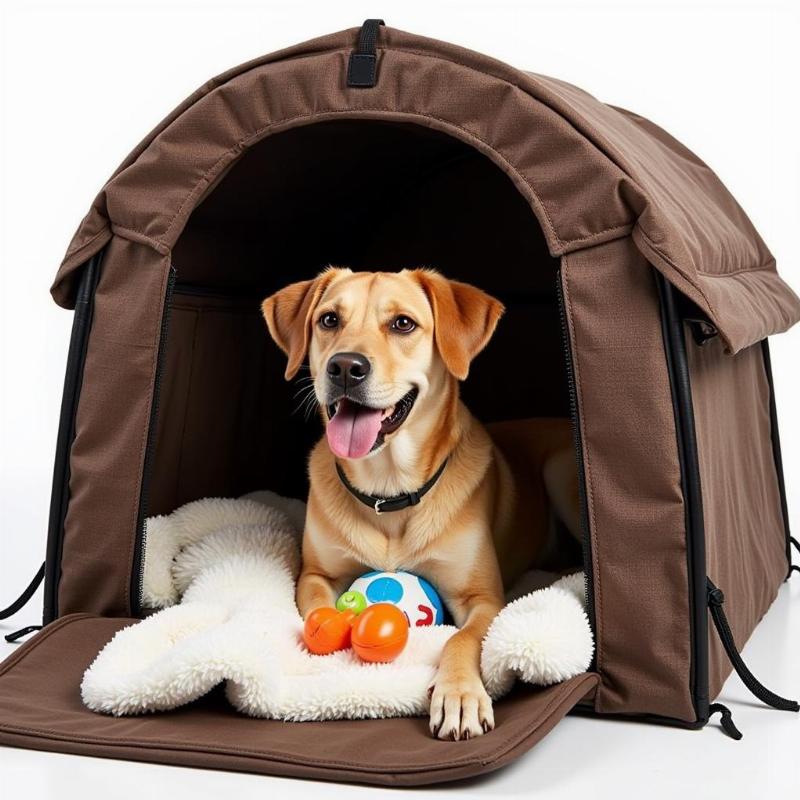Getting your dog to happily go into their crate at night can be a dream come true for many owners. A crate provides a safe, secure den for your dog and can also help with housetraining and preventing destructive behaviors. But how do you achieve this seemingly magical feat of a dog willingly entering their crate at night? This article will explore proven methods and expert advice to help your furry friend see their crate as a welcome retreat, not a confinement zone. We’ll cover everything from crate training basics to creating a positive association with the crate, ensuring a peaceful night for both you and your canine companion.
Creating a Positive Crate Environment
 Creating a Positive Environment Inside the Dog Crate
Creating a Positive Environment Inside the Dog Crate
The key to crate training success is making the crate a positive and inviting space. Start by choosing the right size crate. It should be large enough for your dog to stand up, turn around, and lie down comfortably, but not so large that they feel they can use one end as a bathroom. Line the crate with soft bedding, a familiar blanket, or a cozy dog bed. Adding a favorite toy or chew can also help create a positive association. You can even try covering the crate partially with a blanket to create a more den-like, secure feeling.
Gradual Introduction is Key
Introducing your dog to the crate should be a gradual process. Don’t force them inside. Instead, start by placing treats and toys near the open door, then just inside the door, and gradually further inside. Encourage your dog to investigate and explore the crate at their own pace. Once they are comfortable entering the crate to retrieve treats, you can start closing the door for short periods, gradually increasing the duration.
Feeding Time and the Crate
Associate mealtimes with the crate. Feed your dog their meals inside the crate, starting with the door open and gradually closing it as they eat. This helps create a positive association between the crate and something enjoyable, like food.
Establishing a Nighttime Routine
Consistency is crucial for nighttime crate training. Establish a regular bedtime routine for your dog, just like you would for a child. Take them for a potty break before bedtime, then lead them to their crate with a treat or a chew toy. Once they are inside, give them a goodnight command and leave the room. Avoid returning to the crate if they whine or bark, as this will only reinforce the behavior. They will eventually settle down and learn that the crate is their safe space for the night.
Addressing Potential Problems
If your dog continues to resist the crate or exhibits signs of anxiety, consult with a professional dog trainer or veterinarian. They can help identify any underlying issues and provide tailored guidance. Remember, patience and positive reinforcement are key to successful crate training.
Conclusion
Teaching your dog to go into their crate voluntarily at night is achievable with patience, consistency, and positive reinforcement. By creating a positive crate environment, introducing the crate gradually, and establishing a consistent nighttime routine, you can help your furry friend see their crate as a comfortable and secure den. This will not only provide them with a safe haven but also contribute to a more peaceful night for the entire household. Remember, a happy dog makes for a happy owner!
FAQ
-
How long does it take to crate train a dog at night? It varies depending on the dog’s age, temperament, and previous experiences, but it can take anywhere from a few days to several weeks.
-
What if my dog cries or barks in the crate at night? Avoid returning to the crate if they whine or bark, as this reinforces the behavior. They will eventually settle down.
-
Should I leave water in the crate at night? For puppies or dogs who are not fully housetrained, it’s best to avoid leaving water in the crate overnight to prevent accidents.
-
Can I use the crate for punishment? Never use the crate as a punishment. It should always be a positive and safe space for your dog.
-
What if my dog is too anxious to stay in the crate? Consult with a professional dog trainer or veterinarian for guidance on addressing anxiety-related crate issues.
-
What size crate should I get for my dog? The crate should be large enough for your dog to stand up, turn around, and lie down comfortably.
-
Is it okay to leave my dog in the crate all day? No, dogs should not be left in crates for extended periods during the day. They need regular exercise, socialization, and mental stimulation.
Related Articles on Beautdogs.us
best dog crate for separation anxiety
About Beautdogs.us
Beautdogs.us is your premier online destination for comprehensive dog care information, expert breed insights, and a curated selection of top-quality dog products in the US. Whether you’re a new dog owner or a seasoned pro, Beautdogs.us offers trustworthy advice and resources to help you navigate every aspect of dog ownership. From crate training tips to breed-specific guides, we empower you to provide the best possible care for your beloved companion. Contact us for personalized guidance: Email: [email protected], Phone: +1 501-555-7529.